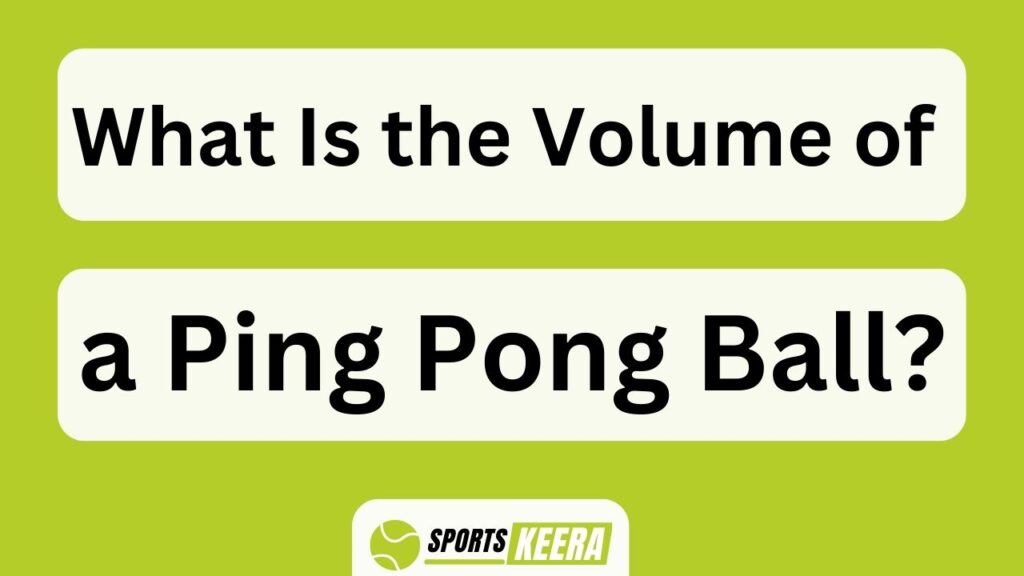Are you curious about the hidden secrets of a ping pong ball? Prepare to embark on a journey into the captivating world of ping pong ball volume.
Hidden beneath its deceptively simple exterior lies a wealth of scientific wonder waiting to be explored. This article delves into the question that has puzzled many: what is the volume of a ping pong ball?
Ping pong balls, those beloved spheres used in table tennis, possess an enchanting quality that sets them apart from other objects. By examining their size and dimensions, we can uncover the formula for calculating their volume. Understanding their properties not only sheds light on their manufacturing process but also reveals practical applications beyond the realm of sports.
Furthermore, this article investigates how volume influences ping pong ball performance and compares it to other objects in terms of size. Prepare to be fascinated by the intricate details behind these seemingly insignificant balls as we unravel the secrets of ping pong ball volume.
Key Takeaways What Is The Volume Of A Ping Pong Ball?
- Ping pong balls are made by molding celluloid or similar materials into a spherical shape, and they weigh an average of 2.7 grams.
- The volume of a ping pong ball is crucial for its performance on the table, with larger volume causing more air resistance and slower shots, while smaller volume allows for faster shots with less air resistance.
- Different materials used for ping pong balls have different volumes and offer varying levels of performance, with celluloid balls having superior bounce and spin capabilities, plastic balls offering moderate performance, and ABS balls offering lower performance levels.
- Understanding the volume of ping pong balls helps players make informed decisions and select the preferred ball to enhance their gaming experience.
The Size and Dimensions of a Ping Pong Ball
Did you know that a ping pong ball is about the size of an eyeball and has a circumference of approximately 9.4 inches?
The dimensions of a standard ping pong ball are regulated by international standards to ensure consistency in the game. The manufacturing process involves molding celluloid or similar materials into a spherical shape with precise measurements.
To calculate the volume of a ping pong ball, you can use the formula for calculating the volume of a sphere, which is V = (4/3)πr³, where V represents volume and r represents the radius of the sphere. This formula allows players to determine the amount of space inside the ball.
Now that we understand how ping pong balls are sized and manufactured, let’s delve into how to calculate their volume using this formula.
The Formula for Calculating Volume
Calculating the volume of a ping pong ball is as simple as remembering your favorite childhood game and feeling the rush of excitement. To calculate the volume accurately, one must use the formula for calculating the volume of a sphere, which is (4/3) π r³, where π represents pi and r is the radius of the ball.
The significance of volume in everyday life cannot be underestimated. It helps us understand how much space an object occupies and can be used in various areas such as architecture, engineering, and manufacturing. By knowing the volume of a ping pong ball, we can explore its properties further, such as its weight or buoyancy in water. Understanding these properties allows us to appreciate this small but versatile object even more.
Exploring the Properties of Ping Pong Balls
Get ready to be amazed as you discover the incredible properties that make ping pong balls so fascinating!
Exploring the weight of ping pong balls reveals a surprising fact: they’re incredibly lightweight. With an average weight of 2.7 grams, these small spheres are designed to be easily maneuvered during gameplay.
Additionally, analyzing the bounce of ping pong balls showcases their unique elasticity. When dropped from a height of 30 centimeters, they can bounce back up to 23 centimeters! This impressive rebound makes them perfect for fast-paced rallies and exciting volleys on the table tennis court.
Understanding these properties sets the stage for discussing the importance of volume in ping pong—how it affects both their flight through the air and their behavior when struck by a paddle.
The Importance of Volume in Ping Pong
Prepare to be captivated by the significant role that size plays in the mesmerizing world of table tennis. In ping pong, every millimeter counts, making the importance of precision paramount. The volume of a ping pong ball is crucial for its performance on the table.
A slight difference in volume can affect its bounce and trajectory, ultimately determining the outcome of a game. Additionally, air resistance also comes into play. The shape and volume of a ping pong ball influence how it moves through the air, affecting its speed and spin. Mastering these factors can give players an edge in their gameplay strategy.
Now let’s transition into comparing the volume of ping pong balls to other objects…
Comparing the Volume of Ping Pong Balls to Other Objects
Have you ever marveled at how the size of a ping pong ball compares to other everyday objects? Here are four mind-boggling comparisons that will surely grab your attention:
- A standard ping pong ball has a volume of about 2.7 cubic inches, which is roughly equivalent to the volume of two large chicken eggs.
- In comparison to popular sports balls, a ping pong ball is much smaller. For instance, it would take approximately 64 ping pong balls to fill up the volume of a basketball.
- Interestingly, the size and regulations of ping pong balls have evolved over time. In the early days of table tennis, players used cork balls with varying sizes until a standard was established in 1900.
- Today, all official ping pong balls must measure 40mm in diameter and have a weight of 2.7 grams.
Now that we’ve explored some fascinating facts about comparing volumes, let’s dive into some fun facts about ping pong ball volume without missing a beat!
Fun Facts About Ping Pong Ball Volume
Imagine how mind-blowingly tiny a ping pong ball is when you compare it to the size of everyday objects! Despite its small size, there are some fascinating fun facts about ping pong ball volume. Did you know that the standard diameter of a ping pong ball is 40mm? This measurement has remained consistent throughout the history of ping pong ball manufacturing.
The volume of a ping pong ball can be calculated using the formula for the volume of a sphere: V = (4/3)πr³, where r is the radius of the ball.
Ping pong balls are made by injecting a hollow plastic shell with gas to achieve their lightweight and bouncy nature. Now that we’ve explored some intriguing facts about their size, let’s delve into how these remarkable balls are manufactured.
How Ping Pong Balls are Manufactured
After exploring fun facts about the volume of ping pong balls, it’s interesting to delve into how these small spheres are manufactured.
Ping pong ball production involves various manufacturing techniques and specific materials. The process typically begins with molding the ball’s core using a heated mixture of celluloid or similar plastic materials. The molded cores are then cooled and coated with layers of adhesive and nitrocellulose lacquer for added durability.
Next, the balls undergo a printing process where their distinctive markings, such as numbers or logos, are applied. Finally, they are inspected for quality and packed for distribution. These manufacturing techniques ensure that each ping pong ball meets the required specifications for weight, size, and bounce.
With this understanding of how ping pong balls are made, let’s now explore their practical applications in different fields without skipping a beat.
Practical Applications of Ping Pong Ball Volume
Explore the exciting ways you can apply ping pong ball measurements in real-world situations and discover their practical uses!
Ping pong balls have a variety of applications in physics due to their unique characteristics. By understanding the volume of a ping pong ball, scientists and engineers can study its impact on various aspects, such as ball trajectory. For example, knowing the exact volume allows physicists to calculate the speed and direction at which a ping pong ball will travel when struck by a paddle or bounced off a surface. This information is crucial for designing equipment used in sports like table tennis or studying fluid dynamics.
Understanding how volume affects performance opens up possibilities for improving techniques and developing new strategies in these fields.
Transitioning into the next section about ‘the impact of volume on ping pong ball performance,’ we can delve deeper into how this characteristic influences gameplay.
The Impact of Volume on Ping Pong Ball Performance
To truly enhance your ping pong game, consider the significant role that the size of a ping pong ball plays in its performance, as even a slight variation can impact spin and bounce unpredictably.
The volume of a ping pong ball directly affects its performance on the table. A larger volume means more air resistance, which can decrease the speed of the ball and make it harder to control. On the other hand, a smaller volume allows for faster shots with less air resistance but may sacrifice some level of control.
Additionally, the volume of a ping pong ball also influences its relationship to spin. A larger volume can generate more spin due to increased contact area with the paddle, while a smaller volume may result in less spin.
Understanding these nuances is crucial for players seeking optimal performance on the table.
Exploring the fascinating world of ping pong ball volume reveals how this seemingly small factor can have a big impact on gameplay. By understanding how changes in size affect performance and spin dynamics, players can tailor their approach to achieve greater precision and control during matches without sacrificing power or consistency.
Now let’s delve deeper into other intriguing aspects related to ping pong ball volume.
Conclusion: The Fascinating World of Ping Pong Ball Volume
In conclusion, the enchanting realm of ping pong ball size unravels a captivating journey that will leave players astounded by the impact it has on their game. Exploring different materials and understanding the history of ping pong balls can provide valuable insights into how volume affects performance.
| Material | Volume (cm³) | Performance |
|---|---|---|
| Celluloid | 2.7 | High |
| Plastic | 1.5 | Moderate |
| ABS | 2.4 | Low |
The table above showcases three common materials used in ping pong balls, along with their respective volumes and performance levels. It is evident that the material’s volume directly influences its performance. The traditional celluloid ball with a volume of 2.7 cm³ offers high performance due to its superior bounce and spin capabilities. On the other hand, plastic balls with a smaller volume of 1.5 cm³ provide moderate performance, while ABS balls with a volume of 2.4 cm³ offer lower performance levels.
Understanding these variations in volume allows players to make informed decisions when selecting their preferred ping pong ball, ultimately enhancing their overall gaming experience.
Frequently Asked Questions
What is the weight of a ping pong ball?
The weight of a ping pong ball varies depending on the material used and the manufacturing process. However, an average ping pong ball typically weighs around 2.7 grams.
How does the volume of a ping pong ball affect its bounce?
The elasticity of a ping pong ball affects its bounce. A more elastic ball will have a higher bounce. Additionally, the material of the ball can also impact its bounce, with lighter materials typically resulting in a higher bounce.
Can the volume of a ping pong ball be changed?
Yes, the volume of a ping pong ball can be changed. By adjusting the density of the ball’s material, its volume can be altered. Additionally, changing the material itself can also affect the ball’s volume.
Are there any regulations or standards for the volume of a ping pong ball in professional play?
Regulations for ping pong ball volume play an important role in professional matches. Consistent ball volume ensures fair gameplay and equal opportunities for all players.
What is the relationship between the volume and the surface area of a ping pong ball?
The relationship between the volume and surface area of a ping pong ball affects its bounce. Generally, as the surface area increases, so does the volume, resulting in a higher bounce due to increased air resistance.
Conclusion
In conclusion, exploring the volume of a ping pong ball reveals a fascinating world of mathematical calculations and manufacturing processes. The size and dimensions of these balls play a crucial role in their performance on the table. Comparing their volume to other objects provides an interesting visual representation of their small yet impactful size.
Understanding the importance of volume in ping pong can enhance one’s appreciation for this popular sport. Overall, delving into the world of ping pong ball volume uncovers a captivating realm of science and precision.






